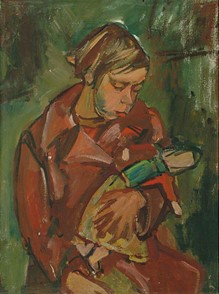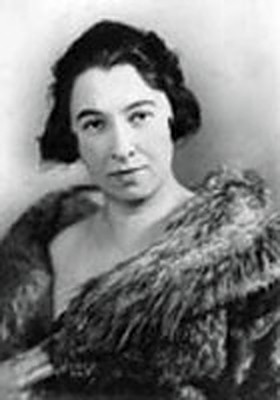Malvern has attracted a fair number of people with refugee status over the last one hundred years or so. The most recent to come under public gaze is an Austrian woman, Frieda Salvendy. Frieda moved to Malvern sometime after the end of the Second World War, and died here, in obscurity, in 1965. A short notice of her death was placed in the local paper and probate details gave her address in Alexandra Road. Beyond that, it would appear that very few, if any, knew of her existence, or that she had been an eminent European artist.

Frieda was born in Vienna in 1887, the only child of a Jewish couple who actively encouraged her artistic talents. She studied art in Vienna from 1902 and some of her early art works date from 1914. Like many of her contemporaries, she shunned the more decorative approach of Art Nouveau and saw painting as a means of spiritual expression. She drew and painted figures and landscapes and was also a printmaker. Like other female artists of her time, she had to work hard in what was still seen as a male profession. Her style met with some hostility over the years but did not stop her from becoming an associate member from 1928-1938 of Hagenbund, a prestigious group of Austrian artists, where she exhibited with others who embraced the newer schools of Expressionism and New Objectivity. Her works were exhibited in Stockholm, Prague, and Vienna, and often in conjunction with the National Organization of Austrian Women in the Visual Arts (VBKO).
Frieda travelled regularly in these pre-Second World War years. Some of her paintings can be dated to a time she spent in Mousehole, Cornwall in c1934. Fishing ports seemed to have appealed to her and she produced several watercolors based on fishing themes. Life in central Europe would soon become more precarious for Jews and so, along with many other Austrians and Czechs who had been at the center of a thriving cultural center, Frieda left for England in 1938. She was by now 51 and had been at the center of an energetic, challenging and celebrated artistic movement.
The 1939 register for Mousehole recorded Frieda living with the Adams family who seem to be part of a burgeoning artistic community in pre-war years. Portraits of the father, Moses Adams, himself an artist, survive and two of his daughters, Anna Grace and Ruth became close friends of Frieda. Several watercolors of Mousehole can be found at the Laing Art Gallery in Newcastle dating from this period.
Frieda’s trail between 1939 and her death in 1965 becomes gradually more elusive. There is a suggestion that she may have been interned on the Isle of Man as an ‘enemy alien’ but if so, it could not have been for long, since the 1939 Register was compiled in autumn 1939 and she was holding exhibitions of her work in Bradford as early as May 1940.
In fact, the British Newspaper Archives reveal that throughout the 1940s, Frieda was actively promoting her artwork. This suggests she was able to transport a good number of her paintings with her in 1938, as some of them have continental themes. Exhibitions were held in Newcastle, Middlesbrough, and Bradford in 1940, and Leicester and Reading in 1941. The Bradford exhibition displayed a number of Frieda’s Cornish paintings, including “the harbor of St Ives and the port of Penzance…expressed in brilliant color and bold outlines.” The following year Manchester provided the venue for her work, and the newspaper item includes a more recent photograph, as well as details of Frieda’s paintings and hopes to obtain a permit to paint more of the Cornish coast. The column goes on to say that Frieda had returned to the continent to see her ailing mother in 1938 and was in Prague when Hitler’s forces marched into the city. More exhibitions were reported in 1944, in Newcastle, Shipley and Cheltenham, and the latter presented no fewer than 50 of her paintings.
A few newspaper references towards the end of the 1940s place her at events in Mousehole, such as a funeral and an art exhibition. No evidence for where she was living has surfaced though. The Malvern Gazette edition of March 26th, 1965, had the following death notice: “Salvendy (Frida) – on March 24, 1965, at Malvern, great painter, grand friend.” There was no obituary, and the probate record reveals she left her estate to her solicitor and Anna Grace Adams. Her address in Alexandra Road is given and the fact that she died at Court House Nursing Home, Malvern. Anna Grace Adams was the friend from Mousehole back in the 1930s. In the 1939 Register, Anna was living in Malvern Wells, near the Cottage in the Woods hotel. This would provide a reason for Frieda to move to Malvern at a later date perhaps. Anna either inherited or remained at the flat in Alexandra Road after Frieda’s death. Anna died in Malvern in 1976, age 87. Local researchers Faith Renger and Cora Weaver of Malvern discovered Frieda’s grave in Malvern Wells cemetery, Green Lane. Her headstone is inscribed with an excerpt from Psalm 42.
In 2003, an Austrian professor appealed for information about Frieda Salvendy through the columns of the Malvern Gazette. It is not yet known if any details were sent to him. Earlier in 2021, another request for information about Frieda was sent to some groups in Malvern including the museum. As a result, some useful lines of enquiry managed to fill in some of the gaps that have been outlined here.
The enquiry came from Martin Sugarman who is the archivist at the Association of Jewish Ex-Servicemen and Women (AJEX) Military Museum in London. He has written a number of books celebrating the wartime contributions by less well-known Jewish men and women, such as firefighters dealing with the aftermath of the Blitz bombings, and men serving in the armed forces or as POWs in Japan. He came across the name of Frieda Salvendy and believed she too should be recognized for her great contribution to 20th century art, especially in the light of the obscurity which followed her escape from Europe. Martin has collaborated with an American Jewish philanthropist, Jerry Klinger, (from the Jewish American Society for Historic Preservation [JASHP]) on some of his projects and Jerry was keen to support Martin’s latest project by sponsoring a plaque in Frieda’s memory.
 As a result, a plaque commemorating the life and achievements of Frieda Salvendy has been placed on the outside wall of the Care Home she spent her last years at.
As a result, a plaque commemorating the life and achievements of Frieda Salvendy has been placed on the outside wall of the Care Home she spent her last years at.
There has been a renewed interest in Frieda Salvendy and her contribution to the art world. Last year the Ben Uri Research Unit in London published Czech Routes to Britain in which Frieda Salvendy is given prominence. She exhibited with Ben Uri in 1945 and 1946 and the book explains how “her reputation is currently undergoing a reassessment.” Some of her work had featured in the Jewish Museum Vienna in 2017 as part of a celebration entitled, ‘The Better Half – Jewish Women Artists Before 1938’.
Frieda’s work appears not only at the Ben-Uri, but in Sussex University, the Sainsbury collection in Norwich, the New Plymouth (New Zealand) Govett –Brewster art gallery, and in Austria.
Republished from San Diego Jewish World
*This article distributed by the Jewish American Society for Historic Preservation (JASHP) was a collaborative effort of Martin Sugarman, Faith Renger, and Cora Weaver.



























HOW WAS HER ART WORK DISTRIBUTED? WHO HAS OWNERSHIP OF IT TODAY?
WE ARE GLAD THAT SOMEONE HAS TAKEN AN INTEREST IN THIS FNE ARTIST WHO HAS SOMEHOW FALLEN INT OBSCURITY. TH YOU. C FINEBLUM